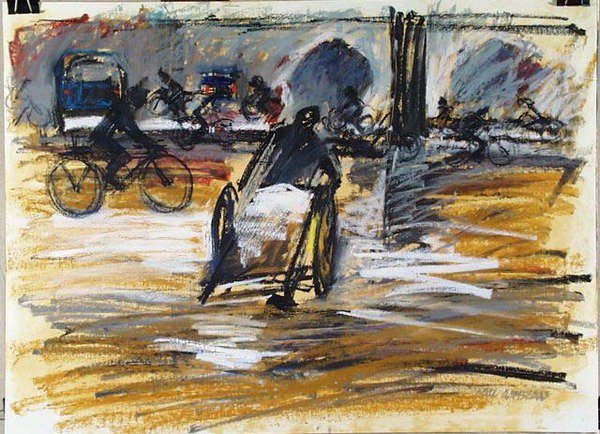Marc Rambeau
dal 29/5/2012 al 8/6/2012
Segnalato da
29/5/2012
Marc Rambeau
SG Private Banking Gallery, Alliance Francaise de Singapour, Singapore
"Recording China" includes works made using rice paper: when the work on paper is complete the sheet is pasted onto fine Belgian linen, then covered with varnish for protection.

Recording China exhibits the story of an encounter: that of the painter
Marc Rambeau with China almost twenty years ago. In 1995 China
had just begun its economic development, thouroughfares were not
flooded with cars but bicycles.
That year Marc Rambeau also discovered a material which would
prove essential to his art: rice paper. However natural it may be to an
Asian artist, rice paper was a totally new medium for the Western
painter who arrived empty-handed in Beijing in order to experiment
new expressive avenues. And his art was transformed by it.
Marc Rambeau has his own way to use rice paper: when the work on
paper is complete the sheet is pasted onto fine Belgian linen, then
covered with varnish for protection. Most of the works currently
exhibited have been designed using this specific process.
Whether he paints with ink or water-based colours – acrylic or water-
colour – Marc Rambeau’s hand is unhesitating, his stroke for ever
pure, thus revealing another specificity of his work: the key-word is
simplicity and the artist « evokes » rather than describes exhaustively.
The exhibition also presents some sketches drawn on French hand-
made rag paper as well as a number of travel diaries depicting
scenes of a bygone life in the streets, parks and hutongs of Beijing.
Marc Rambeau’s exhibition should be seen as a path, the path of
creativity which meanders around the themes born from his encounter
with China in the 90’s: the daily life of the people, the calligraphies of
bicycles, buddhas, architectural details, antiques as well as nudes.
This is Marc Rambeau’s sixth exhibition in Singapore.
Artist Biography
Born in France in 1945, Marc Rambeau studied art at the Villa
Thiole (French
School for
School
for
Visual Arts)
and
at
the
National
Arts Decoratifs in Nice from 1961 to 1963. In 1964, he
joined the Robert Boell Atelier in Toulon where he continued his
studies. From 1968 onwards, Rambeau’s work took him to the South
Pacific where he lived in New Caledonia and Tahiti, until 1985 when
he took up residence in Australia.
In 1989 he became an Australian citizen. As a travelling artist in
1995 and 1996, he resided in Beijing for six months. This stay in
China marked a new era for Rambeau’s art, for he discovered the
rice-paper medium which he has since used extensively for his
paintings. The influence of Rambeau’s time in China is seen in the
deceptive simplicity of his bold calligraphic drawings and his use of
ink on rice paper. East meets West in his colour compositions,
collages and image repetitions.
He used these techniques in the
themes he developed in Tahiti in 1997 portraying
polynesian
dancing and the vibrance of the Tiurai festival ; and then again in
2000 in his ”Around the Buoys” project which captured the colour
and movement of the Americas Cup regatta . In Australia too his
work on the landscape of the Outback is known for its bold simplicity
and strong colours. Rambeau’s Australian studio is located in
Ainslie, in the heart of Canberra.
Her interests are shaped by the awareness of her internal feelings
toward people she came into contact with and find an artistic means
to express those experiences precisely.
Press Office
Benedict Tan, Gallery Manager
benedict@alliancefrancaise.org.sg
T: +65 6833 9314
Opening May 30
Societe Generale Gallery
Alliance Française de Singapour
1 Sarkies Road, Level 2, Singapore 258130
Mon to Fri, 11am to 7pm; Sat, 11am to 5pm
Admission free



